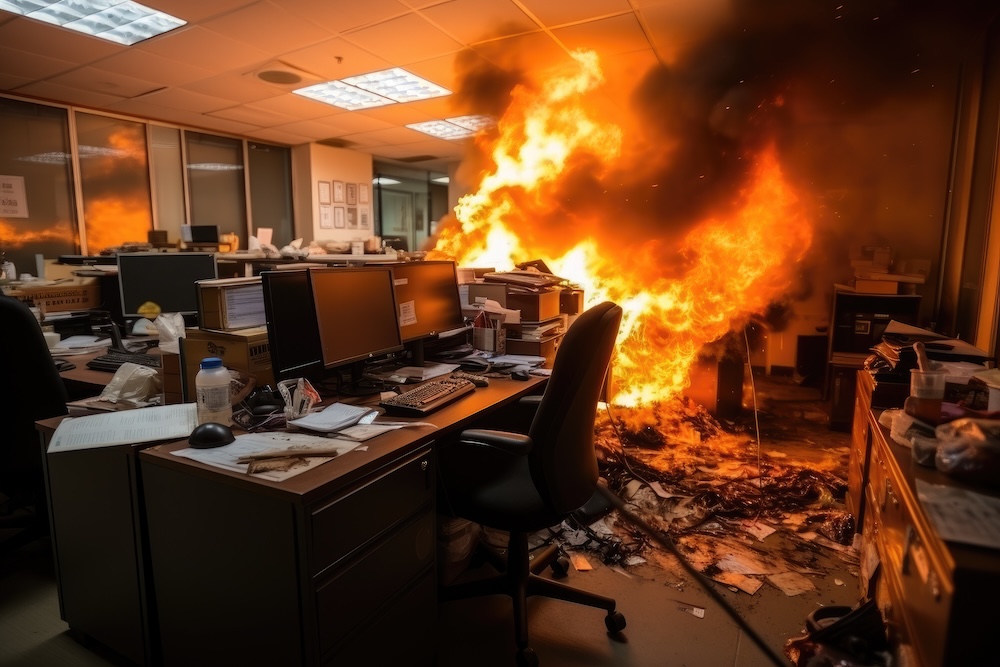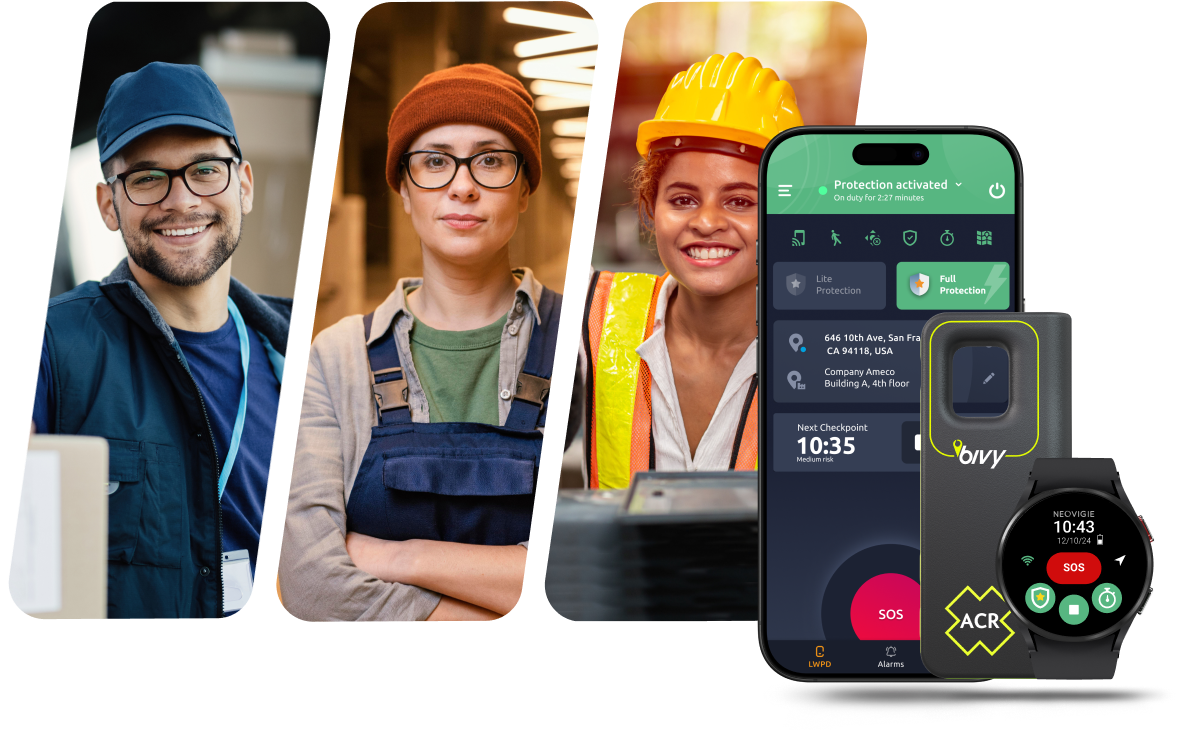

Workplace safety is crucial for every organization. Hazards in the workplace can lead to injuries, illnesses, and even fatalities. This article will explore various types of workplace hazards, their impact, and how to address them effectively. We'll also highlight how advanced safety solutions can help protect employees, especially those working alone.
Workplace hazards are conditions or activities that can cause harm to employees. These hazards are found in various settings, from construction sites to office environments. Understanding these hazards is the first step in creating a safer workplace.
Safety hazards are common and include machinery accidents, slips, and falls. For example, a construction worker might fall from scaffolding if guardrails are missing. Factory workers could suffer severe injuries if caught in unguarded machinery.
Prevention strategies include comprehensive safety training to educate workers on potential risks and proper safety protocols. Providing protective equipment such as helmets, harnesses, and safety guards is essential. Regular safety audits and maintenance checks ensure all safety measures are up-to-date and effective.
Biological hazards involve exposure to harmful agents like bacteria, viruses, and fungi. These are particularly relevant in hospitals, labs, and agriculture. For instance, healthcare workers might contract diseases from patients, while lab technicians could be exposed to dangerous pathogens.
To mitigate these risks, implement strict hygiene protocols, such as regular hand washing and sterilization of equipment. Providing protective gear like gloves, masks, and gowns is crucial. Regular health monitoring and vaccinations for high-risk employees can further reduce the risk.
Physical hazards include extreme temperatures, noise, and radiation. Outdoor and industrial workers often encounter these risks. For example, construction workers might suffer from heat stress during summer or frostbite in winter, and factory workers might face constant loud noise.
Prevention involves providing proper clothing for weather conditions, such as insulated jackets for cold environments or cooling vests for heat. Hearing protection devices like earplugs or earmuffs are crucial for noisy environments. Regular health check-ups help monitor the effects of these hazards on workers.
Ergonomic hazards arise from poor workplace design or practices that strain the body, leading to repetitive strain injuries or back problems. Office workers often suffer from poor posture due to improperly adjusted desks and chairs, and manual laborers might experience repetitive motion injuries.
Prevention includes conducting ergonomic assessments to identify risk factors. Providing adjustable equipment like chairs, desks, and tools is essential. Training employees on proper posture and lifting techniques can significantly reduce the risk. Encouraging regular breaks and exercises to alleviate strain further enhances workplace ergonomics.
Chemical hazards involve exposure to toxic substances, including liquids, gases, and fumes. These can lead to serious health issues like respiratory problems or skin irritation. Workers in chemical plants, cleaning jobs, and certain manufacturing environments are particularly at risk.
Prevention strategies include ensuring proper ventilation to disperse toxic fumes. Adequate storage for hazardous materials and using personal protective equipment (PPE) such as gloves, masks, and respirators are essential. Regular training on handling and disposing of hazardous substances can reduce the risk.

Workload hazards include stress, fatigue, and violence. These are often found in high-pressure jobs and isolated positions. Employees in demanding roles might experience burnout due to excessive workloads or tight deadlines. Lone workers could face increased risks of violence or accidents without immediate support.
Prevention involves effective workload management, such as fair distribution of tasks and providing sufficient breaks. Employee support programs, including counseling and stress management workshops, help workers cope with high-pressure environments. Implementing clear policies for reporting and addressing violence is crucial for a safe and supportive workplace.
Environmental hazards stem from external factors like pollution and natural disasters. These affect outdoor jobs and regions prone to such events. For example, construction workers in urban areas might face health risks from air pollution. Workers in regions prone to earthquakes or floods must be prepared for such emergencies.
Prevention measures include developing comprehensive emergency preparedness plans. Pollution control measures, such as using masks to filter out pollutants, help protect workers. Regular training on emergency procedures ensures employees know how to respond effectively in case of a disaster.
Psychosocial hazards include workplace harassment, bullying, and job insecurity. These can lead to mental health problems and decreased job satisfaction. They can occur in any workplace but are particularly prevalent in high-stress environments. For instance, an employee in a competitive sales environment might experience bullying from colleagues.
Preventing psychosocial hazards involves fostering a supportive workplace culture. Providing mental health resources, such as counseling services, is essential. Clear policies against harassment and bullying can create a healthier and more inclusive work environment.
Electrical hazards, such as shocks, burns, and electrocution, are significant risks in electrical work and construction. Workers might suffer severe injuries if they come into contact with live wires or faulty electrical systems. For instance, an electrician could be electrocuted if they accidentally touch an exposed wire without proper insulation.
Prevention includes ensuring all electrical components are correctly insulated and regularly inspected for faults. Providing thorough safety training on handling electrical equipment and using tools designed for electrical safety can further reduce the risk. Employers should enforce strict safety protocols and ensure only qualified personnel handle electrical tasks.
Fire hazards involve risks from flammable materials and faulty wiring. These are common in manufacturing, kitchens, and chemical plants. For example, a kitchen worker might face the danger of a grease fire if cooking oil is not managed correctly. Similarly, a chemical plant could experience a fire if flammable substances are stored incorrectly.
Prevention strategies include fire safety training to educate employees on preventing and responding to fires. Proper storage of flammable materials, regular maintenance of electrical systems, and installing fire alarms and extinguishers are essential. Regular fire drills ensure all employees know the evacuation procedures and can respond quickly in case of a fire.
Understanding these various workplace hazards is crucial for implementing effective safety measures. Recognizing the risks associated with each hazard allows organizations to tailor their safety protocols to better protect their employees.

To mitigate these diverse hazards effectively, organizations need to adopt comprehensive strategies that address risk identification, policy implementation, and employee training. By doing so, they can create a safer and more productive work environment.
Regular risk assessments are crucial for identifying potential hazards and implementing measures to prevent accidents. These assessments help ensure that workplaces remain safe and compliant with safety regulations.

➡️ Importance of Regular Risk Assessments:
➡️ Steps to Conduct Effective Assessments:
By following these steps, companies can create a dynamic safety culture that adapts to new challenges and continuously improves.
A robust health and safety policy is the backbone of a safe workplace. It outlines the company's commitment to safety and provides a framework for all safety-related activities.
➡️ Key Components of a Strong Health and Safety Policy:
➡️ Implementation and Enforcement:
A strong health and safety policy helps create a proactive approach to workplace safety, ensuring that all employees understand their roles and responsibilities.

Ongoing safety training is vital for maintaining a safe work environment. Training programs educate employees about potential hazards and how to handle them.
➡️ Ongoing Safety Training Programs:
➡️ Tailoring Training to Specific Hazards and Roles:
Employing regular risk assessments, implementing strong health and safety policies, and providing ongoing training creates a comprehensive approach to mitigating workplace hazards. This holistic strategy enhances safety and fosters a culture of continuous improvement and vigilance in the workplace.
Neovigie provides advanced safety solutions tailored to safeguard lone workers, addressing their unique challenges. Here's how our innovative products and services help mitigate various workplace hazards:

VigieApp offers fall detection, panic alarms, and real-time tracking. The app uses sensors to detect sudden drops, signaling potential falls. If a field worker slips and falls, the app automatically alerts emergency contacts, ensuring immediate assistance. This reduces workers' time waiting for help, which is crucial in emergencies.
VigieTouch is a discreet Bluetooth panic button that workers can easily wear or carry. In high-risk situations, such as a security guard facing an intruder, the worker can quickly and discreetly send an alert by pressing the button. This ensures that help is always within reach, even in the most dangerous scenarios.
VigieControl provides centralized monitoring and data analytics with a dashboard for real-time tracking and historical data analysis. Managers can track incidents over time, identify patterns, and implement targeted interventions to reduce risks. This proactive approach helps prevent future accidents and improves overall safety protocols.
Indoor Location Beacons offer precise indoor positioning, enabling accurate tracking within buildings. If a worker in a large warehouse has an accident, the beacons help pinpoint their exact location, ensuring that help arrives quickly. This reduces the time spent searching for the injured person, which can be critical in life-threatening situations.
The system sends alerts via multiple channels, including SMS, email, push notifications, and voice calls. During a chemical spill in a factory, alerts can be sent to on-site emergency responders and off-site management to coordinate an effective response. This multi-channel approach ensures no alert goes unnoticed, improving response times and coordination.
Neovigie's solutions are designed to enhance workplace safety, especially for lone workers. Integrating our technology into your safety protocols can significantly reduce risks and improve emergency response times. Prioritize the safety of your employees and create a secure working environment with Neovigie's advanced safety solutions. Contact us today to learn more about how we can help protect your team.